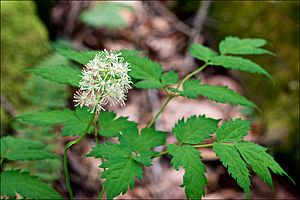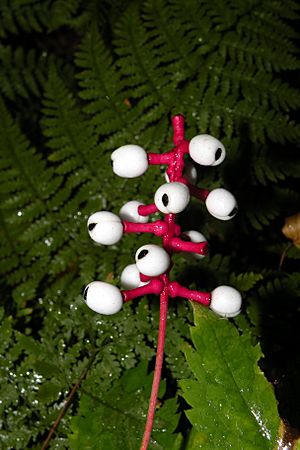White baneberry facts for kids
Quick facts for kids White baneberry |
|
|---|---|
 |
|
| flowers and leaves | |
| Conservation status | |
| Scientific classification | |
| Genus: |
Actaea (plant)
|
| Species: |
pachypoda
|
Actaea pachypoda, also known as the white baneberry or doll's-eyes, is a fascinating flowering plant. It belongs to the Actaea group and is part of the Ranunculaceae family. This plant is native to eastern North America, growing naturally in places like eastern Canada and the central and eastern parts of the United States. You can often find it in forests, especially where there's clay or loamy soil.
Contents
About White Baneberry
This plant is a herbaceous perennial plant, meaning it's a plant without a woody stem that lives for more than two years. It can grow quite tall, reaching about 45 to 75 centimeters (18 to 30 inches) or more. Its leaves are large, up to 40 cm (16 in) long and 30 cm (12 in) wide, and have a unique toothed shape.
Flowers and Berries
In the spring, white baneberry produces small, white flowers. These flowers grow in a dense cluster that is about 10 cm (4 in) long. But the most eye-catching part of the plant is its fruit. These are bright white berries, about 1 cm (0.4 in) across. They have a black spot on them, which makes them look a lot like the eyes of old porcelain dolls. This is how the plant got its common name, "doll's-eyes."

As the berries grow, the small stalks that hold them become thicker and turn bright red. The berries stay on the plant throughout the summer and even into the fall, until the first frost arrives. The scientific name pachypoda means "thick foot" in Ancient Greek. This might refer to the plant's large underground stem or to the thick stalks that support its berries.
Why is White Baneberry Dangerous?
It's very important to know that both the berries and the entire white baneberry plant are poisonous to humans. The berries are the most dangerous part. They contain substances that can affect the human heart. Eating these berries can be very harmful and could even lead to serious health problems. Because of this, you should never eat any part of the white baneberry plant.
White Baneberry in Nature
Even though the berries are harmful to humans, many birds can eat them without any problems. When birds eat the berries, they help spread the plant's seeds to new places. Long-tongued bees also visit the flowers to collect pollen, helping the plant to reproduce.
Growing White Baneberry
People sometimes grow white baneberry in their gardens because it's a beautiful ornamental plant. It's often used in traditional gardens or gardens designed to attract wildlife. If you want to grow it, the plant needs a spot with some shade or full shade. It also prefers rich, loamy soil and needs regular water, but with good drainage. These conditions help it grow well, just like in its natural forest home.
See also
- List of poisonous plants
 In Spanish: Actaea pachypoda para niños
In Spanish: Actaea pachypoda para niños


